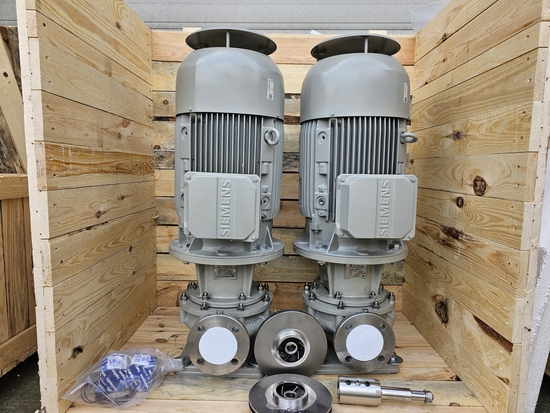 Add My Company
Add My Company

Two Vertical Inline Pumps for Sour Produced Water at a North Sea Offshore Production Facility – Case Study
An oil and gas exploration and production company contacted North Ridge Pumps to commission two ATEX vertical inline pumps for use with sour produced water. 
The company wanted to use the pumps for the transfer of sour produced water at 50m³h at 80m head. This would be on an offshore production facility based in the Helm oil fields in Block Q of the Netherlands sector of the North Sea.
What is sour produced water and where does it come from?
Sour water is the wastewater that’s produced from atmospheric and vacuum crude columns at oil and gas refineries. Hydrogen sulphide and ammonia are common components in sour water, and they need to be taken out before the water can be reused elsewhere in the plant.
In a complex refinery, most of the sour water comes from distillation, fluid catalytic cracking, catalytic reforming, coker and acid gas removal units, with many other processes also contributing. The different streams are collected in a large surge tank for centralised processing through a heat exchanger and a single stripper column, or two in series.
What is sour water stripping?
This is the process of removing the ammonia (NH3) and hydrogen sulphide (H2S) from the sour water streams coming from the many operations mentioned previously. This conditions the water and makes it ready for discharge, or reuse within the production facility.
Sour water stripping is achieved by sending the sour water from the process to the surge tank where heat, in the form of steam, is applied. The ammonia and hydrogen sulphide contained in the water is released by the heat and exits at the top of the tower.
 There are three distinct steps in the sour water stripping process:
There are three distinct steps in the sour water stripping process:
Degasification
During the degasification stage, the sour water feed from the plant is cooled and fed to a degasser where dissolved hydrogen, methane and other light hydrocarbons are removed. These removed gases are known as sour gas and are pumped off using sour produced water transfer pumps to the sulphur recovery unit. This degassed sour water is pumped into a storage tank that dampens the flow rate and enables oil and solids to be removed.
Hydrogen stripping
The next step in the process is known as hydrogen sulphide stripping. The degassed sour water is fed to the acid gas or hydrogen sulphide stripper, which is a steam-reboiled distillation column. The hydrogen sulphide is of high purity and is an excellent feed for sulphur recovery units or sulphuric acid plants.
Ammonia stripping
Finally, the hydrogen sulphide stripper stream, containing all the ammonia in the feed water and some hydrogen sulphide, is fed directly to the ammonia stripper. Here, all of the ammonia and hydrogen sulphide are removed from the sour water. After exchanging heat with the hydrogen sulphide stripper feed, the stripped water is cooled and sent off for either reuse in the plant or treating.
Why is sour water stripping important?
As discussed, the steam drives away the ammonia and hydrogen sulphide from the sour water. The presence of solids and hydrocarbons are major contaminants that can seriously affect the sour water stripping (SWS) process.
If the SWS isn’t working at full effectiveness, bottlenecks can be caused and production rates will drop. This will then have a knock-on effect, leading to more unscheduled SWS shutdowns and cleanouts causing further losses in production and higher maintenance costs.
Worst of all, site workers will be put at greater risk from exposure to the highly volatile H2S in the sour produced transfer water system.
How did our pumps meet the brief?
North Ridge pumps are especially suited to handling sour water at the high pressures required to send liquids through the stripping tower.
Our client wanted two ATEX Vertical Inline Pumps to operate at multiple performance points on-site. In addition, they asked for the pumps to be fitted with a motor which could operate at a range of speeds. This would enable them to alter the speed of the pumps to match their specific transfer requirements.
Full chemical analysis
To enable us to see clearly which chemicals in which approximate concentrations were present in the sour water, the client had a full chemical analysis carried out. This gave us the information we needed to select the correct pump and seal materials.
We built the pumps with casing, impeller and shaft in AISI316 stainless steel and coupled them to SIEMENS IE3 ATEX Motors ready for operation at various duty points as requested by the client. The vertical inline pumps were sprayed with anti-static paint and the coupling was protected.
As the sour produced water transfer pumps were to be installed outdoors in what could be a harsh and rugged environment, we fitted the motors with rain covers to stop water getting in through the fan cover.
Spare parts for two years’ service
As well as the two new pump units, our client also had the foresight to order spare parts for two years’ service, which we were happy to supply.
This meant that should if they encountered any issues during service, they had enough spare parts immediately available to maintain the units, and ensure that production wasn’t disrupted. Along with the pumps and spares, we also supplied two spare mechanical seals, impellers, O rings and shafts.
For more information on Two Vertical Inline Pumps for Sour Produced Water at a North Sea Offshore Production Facility Case Study talk to North Ridge Pumps Ltd

%20(1)%20(1)-23062114255964566-23062114303759445-23062114311890658-23062114360585227.jpg)